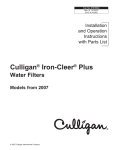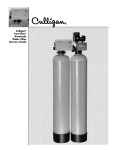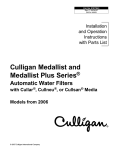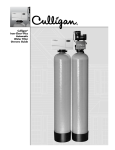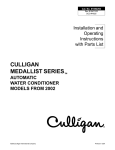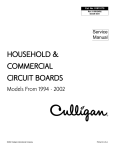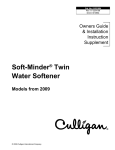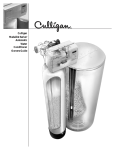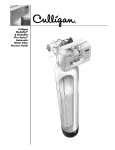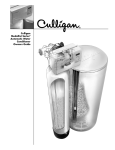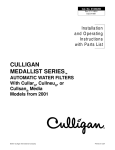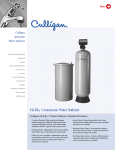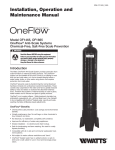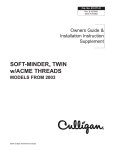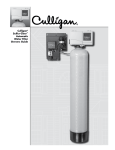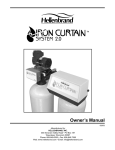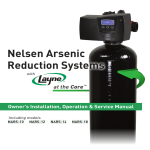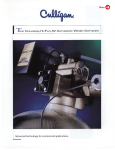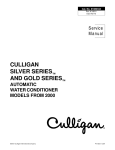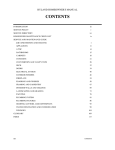Download Iron-Cleer Filters (from 2006)
Transcript
Cat. No. 01018680 Rev. A 10/30/07 DCO # 010258 Installation and Operation Instructions with Parts List Culligan® Iron-Cleer® Water Filters Models from 2006 © 2007 Culligan International Company Attention Culligan Customer: The installation, service and maintenance of this equipment should be rendered by a qualified and trained service technician. Your local independently operated Culligan dealer employs trained service and maintenance personnel who are experienced in the installation, function and repair of Culligan equipment. This publication is written specifically for these individuals and is intended for their use. We encourage Culligan users to learn about Culligan products, but we believe that product knowledge is best obtained by consulting with your Culligan dealer. Untrained individuals who use this manual assume the risk of any resulting property damage or personal injury. Warning! Prior to servicing equipment, disconnect power supply to prevent electrical shock. Warning! If incorrectly installed, operated or maintained, this product can cause severe injury. Those who install, operate, or maintain this product should be trained in its proper use, warned of its dangers, and should read the entire manual before attempting to install, operate, or maintain this product. Culligan International, Inc. 9399 West Higgins Road, Suite 1100 Rosemont, IL 60018 (847) 285-5442 Installation and Operation Instructions with Parts List Culligan® Iron-Cleer® Water Filters Models from 2006 Table of Contents Page Introduction . . . . . . . . . . . . . . . . . . . . . . . . . . . . . . . . . . . .1 Specifications . . . . . . . . . . . . . . . . . . . . . . . . . . . . . . . . . . .2 Preparation . . . . . . . . . . . . . . . . . . . . . . . . . . . . . . . . . . . .3 Installation . . . . . . . . . . . . . . . . . . . . . . . . . . . . . . . . . . . . .8 Settings . . . . . . . . . . . . . . . . . . . . . . . . . . . . . . . . . . . . . .14 Start-Up . . . . . . . . . . . . . . . . . . . . . . . . . . . . . . . . . . . . . .20 Recommended Preventative Maintenance . . . . . . . . . . .21 Troubleshooting Guide . . . . . . . . . . . . . . . . . . . . . . . . . . .22 Operation, Maintenance & Service . . . . . . . . . . . . . . . . .27 Wiring Diagram . . . . . . . . . . . . . . . . . . . . . . . . . . . . . . . .31 Parts List . . . . . . . . . . . . . . . . . . . . . . . . . . . . . . . . . . . . .32 iv Culligan® Iron-Cleer® Water Filters Introduction This system and its installation must comply with state and local regulations. The System is ONLY to be supplied with cold water. The Culligan® Iron-Cleer® water filter has been tested and certified by WQA against WQA-200 for the effective reduction of iron up to 1,400 gallons for 10" units and 2,000 gallons for 12" units. For installations in Massachusetts, the Commonwealth of Massachusetts Plumbing Code 248 CMR shall be adhered to. Consult with your licensed plumber for installation of this system. Safe Practices Throughout this manual there are paragraphs set off by special headings. Notice: Notice is used to emphasize installation, operation or maintenance information which is important, but does not present any hazard. Example: Notice: The nipple must extend no more than 1 inch above the cover plate. Caution: Caution is used when failure to follow directions could result in damage to equipment or property. Example: Caution: Disassembly while under water pressure can result in flooding. Warning: Warning is used to indicate a hazard which could cause injury or death if ignored. Example: Warning! Electrical shock hazard! Unplug the unit before removing the timer mechanism or cover plates! Serial Numbers • • The control assembly serial number is top center on the rear of the timer plate. The media tank serial number is on the top of the sideshell of the tank. Do not remove or destroy the serial number decals. They must be referenced on requests for warranty repair or replacement. This publication is based on information available when approved for printing. Continued refinement of design could cause changes that may not be included in this publication. Introduction 1 Specifications Culligan® Iron-Cleer® Filters Control Valve Timer Overall Conditioner Height Media Tank Dimensions (D x H) Filter Media Type Underbedding G-50 Cullsan U Capacity 1 Freeboard2 Max. Clear Water (Soluble) Iron Max. Hydrogen Sulfide 10" Iron-Cleer 12" Iron-Cleer 1" reinforced thermoplastic 1" reinforced thermoplastic 67" 65" Electro-mechanical Electro-mechanical 2 ea. 10" x 54" tanks 2 ea. 12" x 52" tanks 35 lbs. 35 lbs. 1400 gallons 2000 gallons 10 ppm 10 ppm 1.0 cu. ft. birm 25 lbs. 21" 5.0 ppm 1.5 cu. ft. birm 25 lbs. 18" 5.0 ppm Minimum Alkalinity 100 ppm 100 ppm pH for Hydrogen Sulfide Removal 6.5 - 7.5 6.5 - 7.5 pH for Iron Removal Service Flow @ Pressure Drop (Clean Bed) Normal Maximum 3 Operating Pressure 7.0 - 8.5 7.0 - 8.5 5 gpm @ 8 psi 7 gpm @ 10 psi 20-60 psi 20-60 psi 6 gpm @ 9 psi 9 gpm @ 14 psi Operating Temperature 33-120° F (1-48° C) 33-120° F (1-48° C) Power Consumption, Continuous/Maximum 3 watts/203 watts 3 watts/203 watts Electrical Requirements Drain Flow, Maximum Regeneration Time Backwash Fast Rinse 120 Volts/60 Hz 120 Volts/60 Hz 10 gpm (5.5 gpm minimum required) 10 gpm (8.0 gpm minimum required) 5 - 20 minutes 5 - 20 minutes 5 - 20 minutes 5 - 20 minutes 1 Capacity based on 4 gpm and 10 mg/L of dissolved iron. 2 Measured from top of media bed to top of inlet fitting. 3 Max flow rates & pressure drop characteristics have not been validated by the Water Quality Association. The max specified flow rate at which the system will deliver treated water as validated by the Water Quality Association is defined as service flow. 2 Culligan® Iron-Cleer® Water Filters Preparation Component Description The Iron-Cleer® water filter is shipped from the factory in nine(9) cartons. Remove all components from their cartons and inspect them before starting installation. Control Valve Assembly - Regeneration control valve, small parts package contains installation hardware and consumer literature, including the warranty policy. Media Tank - Two (2) fiberglass tanks complete with fittings. Media - One package of Birm filter media (10" filters), or two for 12" filters, one package G-50 and a package of Cullsan® underbedding. Aeration Head - The aeration head incorporates the compressor and other miscellaneous components. Pick-up Tube - This is the long tube which mates to the aeration head inside the tank. Tools And Materials All Installations • Safety goggles • Phillips screwdrivers, small and medium tip • • • • • • • • Slotted screwdrivers, medium and large tip Pliers, standard or locking groove Gauge Assembly (PN 00304450 or equivalent) Silicone lubricant (PN 00471507 or equivalent) - Do Not Use Petroleum-based Lubricants Lubricating swabs (PN 00591610, carton of 12) Thread sealing tape A bucket, preferably light-colored Towels Special Tools • Torch, solder and flux for sweat copper connections • Threading tools, pipe wrenches and thread sealer for threaded connections • • • • • Use only lead-free solder and flux for all sweat – solder connections as required by state and federal codes. Saw, solvent and cement for plastic pipe connections Snap-ring pliers, external, for three-valve bypass (see following section) For testing the compressor, a gauge (PN 00448621). Adapt to 1/4” tubing. Tank Filling Funnel Materials • Drain Tubing, 1/4” black polyethylene (PN 00303177), 3/8” black polyethylene (PN 01009819) • Pressure reducing valve (if pressure exceeds 60 psi [414 kPa], PN 00400900 or equivalent) • • • Drain line, 1/2" (PN 00303082, gray, semi-flexible; or PN 00331946, black, semi-rigid; or equivalent) Pipe and fittings suited to the type of installation Bleach, 5-1/4%, 1 gallon [3.8 liters] Preparation 3 Bypass Valves Provide a manual bypass to permit water flow to service in the event the water conditioner must be removed or disconnected. Cul-Flo-Valv® Bypass - 1" control The Cul-Flo-Valv bypass connects directly to the control valve bracket. 01016464 Cul-Flo-Valv Bypass 1-1/4" NPT 01016564 Copper Adapter Kit 3/4” Sweat 01010783 01016565 Copper Adapter Kit 1" Sweat Copper Adapter Elbow Kit 3/4” Sweat Operation Solenoid Valve Shuttle Valve Step 1. Aeration Operation Service Cycle In the service cycle, raw water enters the inlet port of the aeration tank and is directed through the inlet diffuser. The oxidation process begins when the water passes through the inlet diffuser and cascades through a head of air. This air/ water contact oxidizes the iron, manganese, hydrogen sulfide in the water. The water is directed toward the bottom of the tank and travels through the pick-up tube. It then passes through the outlet of the aeration tank to the inlet of the filter tank. Timer Filter Tank Operation Service Cycle Raw water enters the filter tank through the inlet port of the filter control valve. Upon system demand for filtered water, water is directed to the top of the tank and flows downward through the multimedia filter bed toward the lower distributor. Oxidized iron particles are trapped by the filter bed as the water passes through. Filtered water enters the lower distributor and travels up the distributor tube to the outlet port on the filter valve. Step 2. Aeration Operation Air Recharge Cycle When energized, the air pump sends air through the solenoid valve into one end of the shuttle valve. Once air pressure in the shuttle valve is greater than the water supply pressure at the other end of the shuttle valve, the piston shifts to the open position. In the open position, the bleed-off port discharges excess water and old air to the drain port through a flow restrictor. Simultaneously, the air inlet port opens to provide a direct connection between the air pump and the top of the aeration tank. The air pump runs for a preset period of time recharging the head of air in the aeration tank. Air Recharge Shut Off The timer turns power off to the air pump and the solenoid valve at the end of the recharge cycle. The solenoid valve then closes the port between the air pump and the shuttle valve. The port between the shuttle valve and the atmosphere opens and releases air pressure. This allows water pressure to shift the piston to the closed position. With the piston in the closed position, the air recharge inlet port is closed and direct communication between the bleed off tube and the drain port is also closed. 4 Culligan® Iron-Cleer® Water Filters Solenoid Valve Aeration Tank Timer Shuttle Valve Timer Operation A timer controls the air recharge cycle and how frequently it occurs. The timer simultaneously energizes the air pump and the solenoid valve. After a preset amount of time, the timer shuts off the air pump and de-energizes the solenoid valve. Solenoid Valve Operation The solenoid valve is a three-way valve having ports that connect to the air pump, shuttle valve and the atmosphere. In the service cycle, the solenoid valve is de-energized and closes the port to the air pump, providing a positive shut-off to the pump. This prevents water from backing up into the air pump and damaging the pump. In the air recharge cycle, the solenoid valve closes the port to the atmosphere and opens the port from the air pump. Shuttle Valve Operation In the service position, water pressure holds the shuttle valve piston in the closed position, trapping the airhead in the aeration tank and closes the air recharge inlet port and drain port. During air recharge cycle, air pressure is greater than the water pressure and forces the shuttle valve piston in the open piston. The shuttle valve has an internal pressure relief valve that will relieve pressure (greater than 100 psi) that may build up in the aeration tank. This precautionary function protects components from failure due to excessive pressure. Step 3. Filter Tank Operation - Backwash Cycle Reversing the flow of water through the filter bed and backwashing dirty water to the drain cleans the filter bed. Raw water enters the filter control valve through the inlet port and is directed down the distributor tube and out the lower distributor at the bottom of the tank, flowing upward through the multimedia filter bed toward the top of the tank into the control valve. Water is then directed through a specific flow restrictor and out the drain port to be discharged to drain. Step 4. Filter Tank Operation - Rinse Cycle The rinse cycle packs the clean filter bed. Raw water enters the control valve through the inlet port and is directed downward through the filter bed into the bottom distributor, up the distributor tube into the control valve. Water is then directed through a specific flow restrictor and out the drain port to be discharged to drain. Operation Of Aeration Pump The Iron-Cleer™ system introduces air into the aeration tank and bleeds off the old head of air automatically. The exchange of the air into the aeration tank is controlled independently of the recharge frequency of the filter media tank, allowing the air to be exchanged on a more frequent basis. During an air exchange cycle, the air compressor pumps fresh air into the aeration tank and the air eliminator solenoid exhausts the old air. Advantages Over Other Systems 1. No chemicals or salt. 3. No floats to regulate air volume in aeration tank which "foul" from iron. 2. 4. 5. 6. 7. No air injectors, venturis, or micronizers. Two-tank system consisting of a pressurized aeration tank and multi-media depth filter. 110V aeration pump to recharge aeration tank. Can be used on shared wells, municipal water supplies or with buried pressure tanks without additional equipment. Better filtration results. Preparation 5 Operating Conditions The concentration limits listed below reflect the maximum individual limit that each contaminant was tested for separately without any interference of other contaminants in the influent water. In reality, however, we know that these contaminants may be present in combination which may limit the filter's ability to remove these contaminants in higher concentrations. In some cases, individual sellers of this equipment have had success removing higher concentrations of contaminants - iron, for example - above the limitations we have listed. If you are considering the installation of this system for the reduction/removal of iron, manganese and/or hydrogen sulfide beyond the printed operating conditions below, we recommend that you consult the manufacturer for proper application. Installation of this system under these circumstances may void part(s) and/or all of the system warranty. pH — The pH level of the influent water must be 7.0 - 8.5. A pH level of 7.0 - 8.5 is optimal for iron reduction and a pH level of 6.5 7.5 is optimal for hydrogen sulfide reduction. Iron — This system is rated for a maximum of 10 ppm of ferrous (clear water) and/or ferric (red water) iron. Consult the factory if iron bacteria is present. Hydrogen Sulfide — Often referred to as rotten egg odor, hydrogen sulfide will be reduced significantly on water supplies containing less than 5 ppm. Consult the manufacturer if hydrogen sulfide concentrations is greater than 5 ppm. Organic Matter (Tannins) — The presence of organic matter such as tannins will prevent the oxidation process of converting the dissolved element, such as iron or manganese, to a non-soluble precipitate or solid substance, allowing it to be filtered out. The Iron-Cleer® is not designed to remove organic bound iron. Unfiltered Water To Outside Hosebibs Filtered Non-Softened Water Iron Cleer™ Softened and Filtered Water Water Softener Note: Waste connections or drain outlets shall be designed and constructed to provide for connection to the sanitary waste system through an air gap of 2 pipe diameters or 25.4 mm (1 in.) whichever is larger. 6 Culligan® Iron-Cleer® Water Filters Iron Cleer Filter Tank Figure 1 Iron Cleer Aeration Tank Raw Water In Pre-Installation Check List ___ Water Pressure: A minimum of 20 psi at a predetermined flow rate is required to backwash the filter properly, with a maximum of 60 psi to be used. If pressure exceeds 60 psi a pressure reducing valve must be installed ahead of the Iron-Cleer® System. ___ Actual Influent Flow Rate: (Water, available from well pump, service inlet, etc.) The actual pumping rate must exceed the backwash rate (drain flow) for the model of filter selected at a minimum of 20 psi. See actual backwash rates in the Specifications section. ___ Electrical Requirements for Filter Control: A continuous 110 volts is required to cycle the controls and aeration pump. Make certain the electrical supply is always on and cannot be turned off with another switch. The system and installation must comply with all state and local laws and regulations. ___ Existing Plumbing: The condition of the existing plumbing should be free from lime and iron build-up. Piping that is heavily built-up with lime and/or iron should be replaced. ___ Equipment Location: See Figure 1. ___ Location of Aeration and Filter Tank: See Figure 1. These two tanks should be installed after the pressure tank and as close to each other as practical. If you want to filter outside hosebibs, be sure the filter system is properly sized to handle the flow rates required for extended periods of time, in addition to the normal household demand. Note: Most codes require an anti-syphon device or air-gap. Observe all local plumbing codes and drain restrictions. The system and installation must comply with all state and local laws and regulations. For installations in Massachusetts, the Commonwealth of Massachusetts plumbing code 248 CMR shall be adhered to. Consult with your licensed plumber for installation of this system. ___ Drain Line: All drain lines must be a minimum of 1/2" or equal to the size of the drain line connection at the control valve or larger. Avoid overhead drain lines when possible. If used, overhead drain lines are not to exceed a height of five feet above the control valve and should be no more than fifty feet in length. ___ Pressure Relief Valve: A pressure relief valve is installed in aeration tank assembly and it is recommended that a separate drain line be extended toward the floor or to a drain receptacle. ___ Temperature: Do not install the unit where it might freeze, or next to a water heater or furnace or in direct sunlight. Outdoor installation is not recommended and voids the warranty. If installing in an outside location, you must take the steps necessary to assure the filter, installation plumbing, wiring, etc. are as well protected from the elements (sunlight, rain, wind, heat, cold), contamination, vandalism, etc. as when installed indoors. ___ Check Valve: On applications where there is a non-filtered demand for water such as joint wells (where the filter system is only installed in one of two or more homes), outside hosebibs, farms with outbuildings, yard hydrants, etc. a spring loaded check valve is provided and must be installed ahead of the aeration tank. See Figure 7. It is recommended to install the check valve in a vertical up-flow position. ___ By-Pass Valves: Two bypass valves are provided with the filter system. One bypass valve is used for the control valve and the other bypass valve is used for the aeration tank. ___ Filtered Water: Normally, filtered water is furnished to all household lines; however, outside faucets are typically left on raw water. If filtered water is provided to outside faucets, the filter system must be sized accordingly. ___ Treated Water: The filter system should be installed after the pressure tank and before the water softener and water heater. ___ Electrical Facilities: A ten(10) foot cord and wall mount plug-in transformer are provided with the filter control. A six(6) foot power cord is provided with the compressor. The customer should provide a receptacle, preferably one not controlled by a switch that can be turned off accidentally. Observe local electrical codes. Note: The filter control valve works on 24v - 60Hz electrical power only. Be sure to use the included transformer. Be sure the electrical outlet and transformer are in an inside location to protect from moisture. Properly ground to conform with all governing codes and ordinances. Preparation 7 Installation Placement Refer to figure 1. • Set the media tank on a solid, level surface near water, drain and electrical facilities. • Set the aeration tank on a flat, smooth, solid structure as near the media tank as possible. Filter Tank Filling It is possible to fill the tank in the plant. If filled at the plant, the tank must remain upright to prevent disturbing the layers. However, because of its weight and handling difficulty, it is advisable to perform this on-site. Proceed as follows: 1. Place the distributor tube in the Filter Tank. 3. Place a funnel in the tank opening and pour several gallons of water into the tank. 2. Use a cork or some other appropriate plug and place it into the distributor tube. This will prevent media from entering the distributor during filling. 4. First pour the Cullsan® material into the tank. The media should be leveled before adding each layer of media. Then pour the G-50 into the tank. Then pour the bag of birm media. When filled the tank should be about two-thirds full. 6. Screw the inlet strainer into the tank. 5. Fill the tank nearly to the top with water. This will allow the media to become soaked while completing the rest of the installation. Mount The Control Valve See figure 2 for a visual on mounting the control valve to the tank. • Assemble the o-rings, located in the parts pack, to the tank adapter. • The valve adapter o-ring sits on the first step on the adapter. See figure 3. Notice: Do not push the top o-ring down to the flange surface on the adapter. Notice: The larger of the two o-rings in the parts part goes between the adapter and the valve, do not stretch the smaller o-ring onto the top of the tank adapter. Lubricate only the top o-ring on the tank adapter, and the outlet manifold o-ring with silicone lubricant. Screw the adapter into the tank until the adapter bottoms out on the tank flange. • Notice: The adapter only needs to be tightened hand-tight to the tank flange. Notice: Make sure to push the valve straight down onto the manifold. If the valve is cocked, it may cause the o-ring to slip off the manifold. Align the manifold with the center opening in the valve, and press the valve onto the adapter firmly. • Figure 2 Notice: The clamp and valve will be able to rotate on the tank until pressure is applied. • Assemble the tank clamp to the control, and tighten the clamp screw. Figure 3 8 Culligan® Iron-Cleer® Water Filters Install Backwash Flow Control Washer Refer to figure 4 1. 2. 3. 4. Locate the thin black flow control washer and the plastic flow control spacer from the small parts pack. Remove the drain elbow retaining clip and drain elbow from the filter control valve. Remove the rubber backwash flow control washer and discard it. Install the thin black flow control washer into the filter control valve with the molded numbers facing the control valve. Install the plastic flow control spacer. Install the drain elbow and retaining clip. Retainer Clip Remove This Flow Control Washer Drain Elbow Install Thin Flow Control Washer Install Plastic Spacer Figure 4 Installation 9 Plumbing Connections General Instructions • Follow local plumbing & electrical codes. Failure to do so may result in your having to re-do the installation at your expense. • Once the plumbing connections have been made to the Cul-Flo-Valv® Bypass, make certain the interior of the valve is clean and free of debris, lubricate the valve stem o-rings with silicone lubricant, reinsert the stem, and replace the red or blue knob. Set the Cul-Flo-Valv Bypass in the bypass position by pushing the red knob completely inward. The main water supply line may then be reopened so that hard water will be available to the household throughout the remainder of the installation process. Take the time to make a clean, professional looking installation. Use flux and solder sparingly when making sweat connections, and avoid excessive use of pipe compound. When using galvanized pipe, clean out excess cutting oil and metal chips before assembly. Foreign objects, if allowed to enter the control valve, can cause operating problems. • Warning! DO NOT remove the Cul-Flo-Valv® bypass knobs or stem while the unit is under pressure! Caution! Close the inlet supply line and relieve system pressure before cutting into the plumbing! Flooding could result! Bypass Valve Installation The bypass valve connects directly to the control valve with a pair of couplings and two assembly pins (Figures 5 a and b). Assemble the o-rings to the couplings. Lightly lubricate the o-rings with silicone lubricant. Assemble the components as shown in figures 5 a and b. Notice: The bypass stem can only be removed from valve on the bypass side (red knob). The bypass valve is designed so that it can be flipped over with the bypass (red) knob on the left side of the valve. This will need to be take into consideration if the control is plumbed in close to a wall which may prevent the stem from being easily removed. The bypass valve has knobs that easily snap on and off of the stem. A screwdriver can be used to depress the snap lever on the stem for knob removal. The knobs have alignment tabs that mate into the notches in the bypass body to ensure that the stem is properly aligned in the bypass body. The service knob (blue) has a locking feature, which must be depressed in order to shift the stem out of the bypass position (Figure 6). Notice: If the ground from the electrical panel or breaker box to the water meter or underground copper pipe is tied to the copper water lines and these lines are cut during installation of the bypass valve, an approved grounding strap must be used between the two lines that have been cut in order to maintain continuity. The length of the grounding strap will depend upon the number of units being installed. In all cases where metal pipe was originally used and is later interrupted by the bypass valve to maintain proper metallic pipe bonding, an approved ground clamp c/w not less than #6 copper conductor must be used for continuity. Check your local electrical code fro the correct clamp and cable size. 10 Figure 6 Culligan® Iron-CleerR Water Filters Figure 5a Figure 5b Drain Lines • • • • • • • Filter Tank Drain Line - Locate the hose clamp in the small parts pack and a length of 1/2” drain line tubing (not supplied). Slide the hose clamp over the end of the drain line tubing. Push the end of the drain line tubing over the drain line fitting, move the hose clamp to within 1/4” of the end of the drain line at the drain fitting and tighten the hose clamp with a screwdriver. Aeration Head Bleed Off Drain Line - Connect 3/8” tubing (not supplied) to the bleed off drain line connection on the aeration head (see figure 7). Solenoid Valve Vent Drain Line - Connect 1/4” tubing (not supplied) to the solenoid vent connection on the aeration head (see figure 7). It is recommended that the 3/8” aeration head bleed off drain line and solenoid valve vent drain line not be connected together. Water flowing to drain from the solenoid vent line is a means of troubleshooting - the solenoid will normally expect very little moisture unless an internal seal fails from within the valve body. Run the drain lines to a suitable waste outlet, such as a laundry tub, floor drain, or stand pipe and in accordance with local plumbing codes. To prevent back-siphoning of drain contents, an air gap is desirable and is required by law in most states. PROTECT THE DRAIN LINE FROM FREEZING TEMPERATURE! DO NOT connect the drain lines together. Cut the drain lines to the required length. Secure the end of the drain line to an immovable object to prevent its being forced out of place during the drain cycle. 1/4” Solenoid Valve Vent Drain Line Connection 3/8” Bleed-off Drain Line Connection Aeration Tank Bypass 1“ Check Valve (Installed Vertically) 1/2” Filter Tank Drain Line Connection Aeration Tank Outlet Filter Tank Bypass Filter Tank Outlet Aeration Tank Inlet Figure 7 Installation 11 Aeration Tank Installation Aeration Head Assembly Quick Install 1. Insert the white disperser into the bottom of the aeration head. Twist it clockwise to lock it into position. Note: The small hole in the white disperser must be in the position shown after it is locked into position. Hole in disperser must be in this position when locked 2. Insert the small grey rigid tube into the white disperser and up into the aeration head. Note: The tube must go into the disperser approximately 8-1/4”, until it contacts the stop molded into the aeration head. Approximately 8-1/4” will remain sticking out of the white disperser. If more than this amount is sticking out of the disperser, the tube is not fully inserted into the aeration head. The tube can be marked with a pencil at 8-1/4” as a visual guide. See figure 9. 3. Locate the large tube provided and mark it 4 3/8” from the end. Insert it into the white disperser and aeration head until it contacts the stop molded into the aeration head. Approximately 4 3/8” of the tube will be in the white disperser when properly seated. Use the mark to verify it is inserted deep enough. See figure 9. Long Large Tube Short Small Tube Disperser 4. Figure 7 Figure 8 Tighten the screw on the white disperser to secure the two tubes as shown. Retaining Screw Lubricate O-ring 5. Install the assembly onto a tank. 6. Locate the bypass valve, inlet elbow, and 1” threaded adapters. 7. Lightly lubricate the external o-rings on the bypass valve with silicone lubricant. Connect the bypass valve to the inlet and outlet connections on the rear of the aeration head assembly. Note: Tighten the plastic nuts by hand only. Figure 9 Bypass Valve Figure 10 12 Culligan® Iron-CleerR Water Filters 8. Lightly lubricate the o-ring on the plastic elbow check valve with silicone lubricant and then assemble it to the inlet port on the bypass valve as shown. Note: the inlet of the plastic elbow check valve must face down when installed. Note: No extra external check valve is required. Note: Tighten the plastic nuts by hand only. Plastic elbow fitting Must Face Down 9. Assemble the 1” threaded fittings using the fittings, nuts, O-rings, and split rings provided. Follow the illustration that is packed with the fitting kit. Lightly lubricate the o-rings on the threaded fittings with silicone lubricant. Assemble one of these fittings to the inlet of the plastic elbow and assemble the other one to the outlet port on the bypass valve as shown. Note: Tighten the plastic nuts by hand only. Figure 11 Outlet to Filter Tank 1” Plumbing Connectors Aeration Tank Inlet 10. Run 1/4” tubing from the solenoid valve exhaust port and 3/8” tubing from the aeration head drain connection to an atmospheric drain separate from the filter drain. Figure 12 Solenoid Valve Exhaust Port (1/4” Tube Connection) Tube This To Atmospheric Drain Aeration Head Drain Connection (3/8” Tube Connection) Tube This To Atmospheric Drain 11. The outlet of the aeration tank is then connected to the inlet of the filter tank. 1” diameter pipe is recommended. Figure 13 12. Remove the front cover from the unit so the time delay relay can be seen. The off time (in hours) is set with the knob on the white “plug-in” style relay. Compressor “ON” time is fixed at 6 minutes. Set the “OFF” time with this knob. Figure 14 Installation 13 Aeration Tank – Bypass Valve Operation Normal Operation “Treated” Water Exits Supply Water Enters Diagnostic Mode Supply Water Exits 14 Culligan® Iron-CleerR Water Filters Supply Water Enters Bypass Operation Supply Water Exits Supply Water Enters Shut-Off Mode No Water Exits Supply Water is Shut Off From The House and The Valve Settings Your Culligan® Iron-Cleer® Water Filter is designed to perform efficiently on a wide range of water supplies. Before the unit can be recharged and put into service, several settings must be made. Backwash Step Backwash expands and loosens the media bed, and flushes away accumulated particulate matter. The backwash interval is preset at the factory for 10 minutes, which is adequate for most water supplies. It is recommended that backwash last just long enough so that the effluent from the drain line is clear. Backwash too long and water is wasted, not long enough and the tank becomes fouled with sediment. Refer to the Programming section to increase or decrease the backwash interval. Pause Step The Medallist Water Filter shares its timer with other water conditioning products which would use this period for the eduction and rinsing of salt, or other regenerant chemical. The pause step duration is 1 minute. Rapid Rinse Step Rapid rinse settles and compacts the media after backwashing and flushes any residual particulate matter from the bottom of the filter bed before returning the filter to service. Rapid rinse is set at the factory at 10 minutes. It may be extended, if desired. Refer to the Programming section to increase or decrease the rapid rinse interval. Backwash Frequency Iron Applications 0.3 - 3.0 ppm Iron - Every 3rd Day 3.0 - 6.0 ppm Iron - Every Other Day 6.0 - 10.0 ppm Iron - Every Day 10+ ppm Iron - Consult Factory Air Recharge Frequency Note: Settings based on average pressure (50psi) and less than 500 gallons daily use. Note: The iron level plus 2 times the hydrogen sulfide level should not exceed 10 ppm. Iron-Cleer® Compressor off Times (Hours) PPM Iron 0 1 2 1 24 8 4 3 24 0 2 4 5 6 7 8 9 10 – 24 24 12 12 12 12 12 8 8 8 8 8 6 6 4 4 4 4 4 H 2S 3 4 2 2 2 2 2 2 5 2 1 2 2 6 12 Settings 15 Programming Make sure the inlet water supply is turned off, then supply power to the timer. The display will power up flashing "12:00 PM" and the motor will energize and cycle the control, without stopping, to the home position. This is required to ensure that the control is in the home position. The 1. 2. 3. 4. timer uses four buttons: STATUS . . . . . . . . .Advance timer through display options. PLUS SIGN "+" . . .Increase the setting. MINUS SIGN "-" . .Decrease the setting. REGEN . . . . . . . . .Initiate a manual regeneration. Programming the Option Settings Figure 15 - Circuit Board Display The microprocessor has several programming options that can be changed for various additional functions. Listed are the functions for the programming options used on the Culligan Medallist Series™ control. Dip Switch 1 2 3 4 5 6 Function Service or Test Delay or Immediate Regeneration Softener or Filter Time Clock Backup English or Metric 3/4" or 1" Meter Default Position Service Delayed Regeneration Softener OFF English 3/4" Meter IMPORTANT: The Medallist control is shipped from the factory in the softener mode. The program setting must be changed from the softener mode to the filter mode - see step number 3. 1. Service or Test Mode Press and hold the “STATUS” key until “dIP1” appears in the display. “dIP1” will blink for 3 seconds and then the display will show the status of this option (SEr or tES). Toggle the feature with the “+” or “-” key. Note: Pressing “STATUS” after changing option to test mode will place the control in test mode. After testing is complete press and hold “STATUS” for 3 seconds to return to service. Placing the unit in test mode will not change any of the programmed values (Refer to the service manual for test menu). 2. Delay or Immediate Regeneration Press the “STATUS” key. The display will blink “dIP2” for 3 seconds and then show the current status. Toggle between “DEL” (Delay) and “Id” (Immediate) with the “+” or “-” key. Note: Changing this setting will not change any of the programmed value with the exception that Step #2, time of regeneration will be ignored when set to immediate. 3. Softener or Filter Press the “STATUS” key. The display will blink “dIP3” for 3 seconds and then show the current status. Toggle between “SOF” (Softener) and “FIL” (Filter) with the “+” or “-” key. Note: Changing this setting will cause the unit to load the Filter or Softener defaults. 4. English or Metric Press the “STATUS” key. The display will blink “dIP5” for 3 seconds and then show the current status. Toggle between “En” (English units) and “MET” (Metric units) with the “+” or “-” key. 16 Culligan® Iron-CleerR Water Filters DEL F IL 5. 12 or 24 Hour Clock Press the “STATUS” key. The display will blink “dIP6” for 3 seconds and then show the current status. Toggle between “12 Hr” (12 hour clock) and “24 Hr” (24 hour clock) with the “+” or “-” key. Setting the Microprocessor The microprocessor senses when it is installed as a Soft-Minder® control. Adding or removing any connection to the board will automatically reset the microprocessor to the factory settings. Step 1 – Programming Time of Day Press the “STATUS” key. The display will blink “tod” for 3 seconds and then change to time of day with the “ones” digit blinking. Adjust the “ones” digit with the “+” or “-” keys. Press the “REG” key to blink the “tens” digit. Adjust the “tens” digit with the “+” or “-” keys. Press the “REG” key to blink the “hours” digit. Adjust the “hours” digit with the “+” or “-” keys. Press the “REG” key to cycle back to “ones” or Note: The “hours” setting scrolls through 1-12 AM and 1-12 PM. Make sure the proper AM or PM indicator is shown when setting the time. No indicator will be shown for AM. Step 2 – Programming Regeneration Time Press the “STATUS” key after setting the time of day. The display will blink “tor” for 3 seconds and then change to the time setting with the “ones” digit blinking. Adjust regeneration time as time of day above. Note: This option will not show if the “dIP 2” option is set to immediate Step 3 – Programming Backwash Time Press the “STATUS” key after setting regeneration time. The display will blink “bw” for 3 seconds and then display the backwash time in minutes. Adjust the setting with “+” or “-” key. (1-40 minutes) Step 4 – Programming Fast Rinse Time Press the “STATUS” key after programming the backwash time. The display will blink “Fr” for 3 seconds and then display the Fast Rinse Time in minutes. Adjust the setting with “+” or “-” key. (5-30 minutes) Step 5 – Days to Regeneration Press the “STATUS” key after programming the fast rinse time. The display will blink “CAP” for 3 seconds and then display the number of days between regenerations. Adjust the setting with the “+” or “-” key. (1-42 days) PM PM 12:00 2:00 10 10 3 Programming 17 Exiting Program Mode From Step 5 press the “STATUS” key. The display will go blank. Press the “STATUS” key again to exit programming. Note: The control will exit the programming mode if no key press activity takes place within one minute. Locking the Programmed Menu Press and hold the “+” key for 3 seconds while in the service mode. The display will show the status of the lock feature. (“LoC” or “unL”) Adjust with the “+” or “-“ key. Press the “STATUS” key to return to the service mode. Note: While the programmed menu is locked (“LoC”) all of the programming menu items will display, however only the time of day can be changed. Note: If programming times out, values will not be saved. The “Status” key must be pressed to save values. 18 Culligan® Iron-CleerR Water Filters Manual Cycling The Culligan® microprocessor can be indexed through the various regeneration steps. For all steps, the cycle numbers do not appear, or change, until the motor stops. 1. Press the status button to move past the programming steps until the display is blank. From blank display press the “+” key. An "H" will appear in the display. The control is in the HOME position. REG 2. Press and hold the regen button. The 'REGEN' icon will blink, and the motor will advance the control. A '1' will appear. The unit is now in the BACKWASH position. The numbers to the right indicates the time remaining for the cycle. REG 3. Press the “+” key. A '2' will appear in the display, along with the cycle time remaining. The control is in the PAUSE cycle. REG 4. Press “+” key. A '3' will appear in the display, along with the cycle time remaining. The control is now in the FAST RINSE cycle. Note: The time displayed is rounded down to the closest minute. REG 5. Press the “+” key. An 'H' will appear in the display. The unit is in the HOME position. The 'REGEN' enunciator is no longer blinking. 6. Press the status key. Time-of-Day appears in the display. Note: If the “+” key is pressed to cycle the value from position “3” to “Home”, the # regen counters will not be updated. PM H 00 1 10 2 01 3 09 H 00 7 : 28 Manual Cycling 19 Service Check The service mode allows one to view the number of regenerations in the past 14 days, the total number of regenerations the control has cycled through and the number of days since the last regeneration. To enter the service check mode, follow these steps: 1. From the Blank display: 2 2. Press the “-” key. The display will blink “14dY” for 3 seconds and then display the number of regenerations that have occurred in the last 14 days. 3. Press the “-” key. The display will blink “totL” for 3 seconds and then display the total number of regenerations this control has cycled through. 4. Press the “-” key. The display will blink “daYS” for 3 seconds and then display the number of days since last regeneration. Note: Pressing the “+” key at any time brings back to manual cycling. Pressing “Status” will Exit the programming menu. 20 Culligan® Iron-CleerR Water Filters 93 5 Start-Up Caution! The media must be soaked for at least 12 hours before start-up (see preparation). Filling the tank without presoaking will likely cause media loss! 1. Once all plumbing is finished and with the unit on bypass, flush the plumbing system until water is clear and no foreign material is detected. 2. Initiate an extra recharge by pressing and holding the “REGEN” button for approximately 3 seconds. 3. Plug in aeration pump. Open the inlet valve on the by-pass to the aeration tank and allow the tank to fill with water and come up to full line pressure. You do not have to wait for the air recharge cycle (air pump running) to finish before proceeding to the next step. 4. Slowly open the outlet valve on the by-pass(s) for the aeration tank and filter. 5. Allow the unit to fill slowly until water flows from the drain. 6. When water flows to drain, open the inlet valve fully. Watch the drain discharge for media particles. If media particles appear, reduce the flow. Increase the flow again when media particles no longer appear in the discharge. When the unit is filled with water, return the timer to the service position. 7. Start-up is complete. Caution! If a sudden rush of water enters the filter, some of the media could be thrown up into the control valve. Warning! Although not normally necessary, should you need to disassemble any part of the control valve or remove the control from the tank assembly or associated plumbing, depressurize the unit first closing the main supply valve, then open a convenient faucet down stream from the water conditioner. Start-Up 21 Preventative Maintenance Recommended Preventative Maintenance The Culligan Iron Cleer water filter has been designed to provide a good, consistent service life. Because of the nature of problem water, we recommend that the local Culligan dealer provide regular maintenance/service contracts for the proper operation of your systems. The water filter service begins with a multi point inspection of your water filter system in an effort to uncover any and all problems that may exist. Listed below is a recommended list of maintenance items to be inspected at a minimum of once a year (or more frequently depending on the raw water quality). Test Water Hardness Feed Product Iron Hydrogen Sulfide Chlorine TDS Comments: Other Bypass Valve Bypass in Service or Bypass? Condition of bypass valve Operation OK? Control Valve Condition of Seal Pack Condition of Solenoid Valve Condition of Motor: Condition of Flow Control Condition of Switches: Condition of Check Valve Condition of Shuttle Valve Condition of Compressor Control settings Check /reset Circuit Board Before Output PSI After Check time of regeneration Time delay relay setting "Off Time" in hours Backwash step (minutes) Pause step (minutes) Rapid Rise step (minutes) Cycle control Media Tank Freeboard inches: Media Condition Iron Cleer: Condition of strainer in Aeration Tank 22 Culligan® Iron-CleerR Water Filters Test Cycle Backwash Fast rinse OK? Troubleshooting Guide Complaint Iron bleed-through or staining. Problem A. Inadequate backwash of filter Cause Solution 2. Insufficient water supply from well. 2. Check for minimum specified flow and pressure requirements of filter system. 1. Plugged drain line flow control 3. Plugged aeration tank inlet diffuser or pick-up tube. 4. Media bed fouled. B. Fails to regenerate 1. Interrupted electrical service. 2. Faulty circuit board. 3. Faulty drive motor. 4. Circuit board set incorrectly. C. Water contaminant 1. It is not uncommon for local water levels are greater than conditions to change. limits established by the manufacturer D. Inadequate aeration 1. Loss of air through inlet check valve. 2. Loss of air through air leak. 3. Faulty aeration pump. a. Electrical failure b. Pneumatic failure c. Damp environment E. Exceeding recommended filter system flow rate. 4. Air loss through high demand . 1. Service flow rate demand is higher than filter system design flow rate. 1. Clean or replace drain line flow control 3. (Generally will only plug with the presence of iron bacteria.) Clean aeration assembly and shock treat the water supply with chlorine as needed to control iron bacteria. 4. Rebed filter and correct the cause of fouling. 1. Assure continuous electrical supply (check plug, breaker, fuses, etc.). 2. Replace circuit board. 3. Replace drive motor. 4. Reset circuit board. 1. Consult manufacturer. 1a. Check installation position of check valve - Consult Installation and Operation Manual for proper position. 1b. Check for foreign material in seat of check valve, clean or replace as required. 2. Check aeration tank assembly and air recharge line and fittings for any air leaks and repair (Note: soapy water solution works well for locating air leaks) a. Assure permanent electrical service (check plug, breaker, fuses, terminal block on control valve, etc.). b. Check for adequate pressure and volume production from air pump. c. Clean, repair or replace aeration pump, ventilate environment or provide external air source. 4. Increase regeneration frequency of filter. 1a. Install a flow control at filter system outlet equal to or less than the design flow rate of filter system. 1b. Install additional filter(s) or a larger single filter system which meets both the service flow demand and backwash flow requirements available. Troubleshooting Guide 23 Complaint Problem Cause Solution G. Raw water bleeding through filter. 1. Internal control valve leak. 1a. Assure all adapter base o-ring seals are in place Water leaking from relief valve. A. Dirt lodged under seat of valve. 1. Pressure has exceeded rating on relief valve and caused valve to open Water is effervescent A. This can be expected when water is aerated under pressure. 1. Water supply has been naturally aerated under well system pressure. As water is released to the atmosphere, air molecules separate from the water molecules. Iron bleed-through or staining. Cont. Loss of pressure F. Regeneration during service flow demand. B. Faulty or defective relief valve A. See complaint #1, problem A & B Air spurting at outside A. Inlet check valve or non-filtered water not sealing. fixtures. Air spurting from filtered water fixtures. Loss of media through drain line. 24 1. Improper installation location. 2. Foreign material preventing check valve. A. New filter backwashed during first 24 hours after installation. 1b. Replace seals, spacer and piston assemblies. 1. Check pressure on system. Adjust if necessary. Clean or replace relief valve. 1. Replace valve 1. This natural phenomenon will typically dissipate to the atmosphere in a matter of seconds. If preferred, water can be drawn and stored in an open container prior to use (i.e. fill a pitcher and store in the refrigerator for cool, fresh drinking water). 1. See installation and operation manual for proper location of inlet check valve 2. Clean or replace check valve. 3. Replace check valve 2. Water flow is restricted by supply piping and/or water treatment equipment. 2a. Eliminate restrictions in supply piping to water treatment equipment such as iron bacteria plugging the upper diffuser assembly, etc. 1. New filter media is shipped in a dry condition and must soak for 24 hours to become fully saturated before a backwash cycle. 1. Excess air accumulated in aeration tank from aeration pump. 2. Excess air accumulated in filter system from water supply or well pump. A. Howling or 1. Inadequate drain line size. whistling noise during 2. Drain line is vibrating against other regeneration cycle. pipes, conduits, pipe hangers, heat ducts, floor joists,etc. Culligan® Iron-CleerR Water Filters 1. Reset timer. 3. Worn or faulty check valve. A. Reduced pressure 1. Service flow demand is greater than in distribution system. water supply available from well pump system. B. Air passing through filter during backwash. Excessive noise during regeneration . 1. Time of day set incorrectly. 1. Repair or replace well pump system. 2b. Install larger water treatment system to provide less pressure drop. 1. Clean drain line flow control, control valve body, seals, spacers and piston assemblies 1. Bleed-off valve flow control is plugged with foreign material - clean or replace. 2a. Repair well pump system. 2b. If the cause was due to temporary loss of water main pressure; the problem will most likely correct itself with the return of continuous pressure. 1. Increase drain line size 2. Insulate drain line, specifically at points of contact with other materials. Complaint Water is running to drain continuously. Problem A. Control valve is stuck in regeneration cycle. Cause Solution 2. Faulty circuit board. 2. Replace circuit board.. 1. Electrical service to control(s) has been interrupted. 3. Faulty drive motor. 4. Foreign material lodged in piston. Blue green staining. Compressor doesn't run. Compressor run with excessive noise. Compressor runs continuously. A. Corrosive water condition in copper distribution piping system. 1. Assure continuous electrical service is available. (check plug, breaker, fuse, etc.) 3. Replace drive motor. 4. Disassemble and clean control valve, replace seals, spacers and piston assemblies. 1. Low pH condition of the raw water supply. 1. A Cullneu® filter may be required to elevate the pH - consult factory. 1. Compressor unplugged. 1. Plug it in. 3. Bad relay. 3. Replace relay. 2. In rare occasions, highly aerated water in combination with a specific water supply can create a slightly corrosive condition. 2. Relay settings incorrect. 1. Dead head pressure is 65 psi. 2. Dead head pressure is 65 psi. 1. Incorrect relay settings 2. Bad relay. 2. Install a polyphosphate cartridge filter after the Iron-Cleer Filter System to protect the distribution piping. 2. Set relay correctly. 1. Consult factory. 2. Rebuild compressor. 1. Set relay settings correctly. 2. Replace relay. Troubleshooting Guide 25 Circuit Board Troubleshooting Error Codes There are certain conditions that can be interpreted by the circuit board as a failure of the drive motor or motor position switch. Upon failure detection the control will cease further operation. A telephone hand set symbol will be shown in the upper left corner of the display and the error code will be shown. Listed below are the different error codes. 1. Motor Always Turning - Error code "E1" occurs when the circuit board detects changes in the motor program switch when the motor is not supposed to be turning. The phone icon and "E1" will be lit in the display. 3. Homing Error - Error code "E3" occurs when the circuit board detects when the control is unexpectedly in the home position. The phone icon and "E3" will be lit in the display. 2. Motor Never Turns - The Culligan Medallist Series control is equipped to detect no change in the motor position when the motor is supposed to be turning (motor or piston locked in a frozen position). The AccuSoft circuit board will apply power to the motor for 20 seconds. If there is no change in the motor homing or position switch, the control will power down for 1 minute. The circuit board will repeat this procedure two more times in an attempt to remove the obstruction. If no movement has been detected, the control will permanently power down and a phone icon and an "E2" will appear in the display. Error Display Cancellation The error code display can be removed by removing the power to the control for 1 minute. After clearing an error condition, the control will default to the factory settings when power is restored. Circuit Board Troubleshooting Most circuit board problems are caused by outside influences and it is not the board itself. Replacing the board may seem to work only because the cause hasn’t reappeared – yet. Let’s start with what to check when you come upon a circuit board problem: 1. 2. 3. 4. 26 Are those switches aligned too closely to the cam? There should be a small but obvious gap between the switches and the cam so that a “wobbling cam” doesn’t accidentally bump the switch. Has the seal pack been checked for free movement? Feedback and experience has demonstrated that seal packs that are over-tightened create drag on the motor and delays that would result in an error code: If the motor never stops (still runs after the desired position is sensed, causing unexpected switch closures) OR if the motor gets stuck “timing out” and the control never sees any switch action. Are all the wiring terminals tightly connected? Sometimes a loose or poorly connected wire can give feedback to the board that would result in an error code or default. After checking all of these possibilities you should run the diagnostics (test mode) on the board. Culligan® Iron-CleerR Water Filters Listed below are some other circuit board problems and their explanations: Board skips the service position or only stops for a second in service before advancing to the backwash position Board has been armed for regeneration. Let the board time out of all three cycles or reset and reprogram the board. Resetting the board can be done by connecting or disconnecting the meter cable. Motor runs continuously Only one of two things can happen when this is the case; it can find its desired position or it gives you an error code. So, LET IT RUN until you find out which will occur. • • If the motor still runs or there is power to motor after the error code is displayed, then the triac is likely bad – change the board. If the error code is displayed and the motor is stopped (no power to the motor), check switches, cam and wire harness – the board got a signal it wasn’t supposed to or a connection failed. A word about triacs – A triac is an electronic switch and can "latch on" when it becomes overheated from a laboring motor (tight seal pack). It may operate properly when it cools down. A continuously running motor could be caused by an overheated triac. Checking the seal pack and voltage draw and allowing the triac to cool down could give you favorable result and prevent the need to change the board. Otherwise, when it is sent to Returned Goods it could test good and be returned. You clear an error code and it starts into regeneration It was either in regeneration or has kept track of time since the error code occurred and it’s trying to finish the regeneration. Reset and reprogram the board. The board repeatedly defaults, resets or gains time Look at the power supply or source. Most of these issues are caused by the power source, so-called “dirty power” having noise interference or incorrect voltage. This could be erratic fluctuations caused by other heavy power draws, poor wiring, low voltage wiring running along high voltage, having active electrical storms that causes “corruption” of the EEPROM. Consider the use of a surge protector or an uninterruptible power supply after you see this repeatedly. If you suspect the power source is causing problems, take a voltage reading at the outlet, at the power connection on the board, and on the motor leads while the motor is running. We are looking for a consistent range of 108-132 volts at the receptacle and 22-28 volts on the board. Also, the wall transformer is only used to step down the voltage; it is not used for protection or filtering the power source. Circuit Board Troubleshooting 27 Service Familiarize yourself with the replacement procedures and component parts thoroughly before attempting any repair. Warning! Disconnect all electrical power to the unit before servicing. Bypass the unit and relieve system pressure before attempting to repair. Circuit Board To replace the AccuSoft™ circuit board, refer to figure 16 and the parts list and proceed as follows: 1. 2. Lift up the front cover of the control. Remove all connected wire leads from the board. Caution! Grip all connections to the circuit board by the connecting terminals for assembly and disassembly. Failure to do so could result in damage to the wire leads or connecting terminals. 3. Remove the circuit board from the retaining clips on the front cover. 4. The new circuit board can be installed by reversing the steps 1-3 above. Caution! Do not touch any surfaces of the circuit board. Electrical static discharges may cause damage to the board. Handle the AccuSoft circuit board by holding only the edges of the circuit board. Keep replacement boards in their special anti-static bags until ready for use. Mishandling of the circuit board will void the warranty. Caution! The wire connectors must be connected to the circuit board properly. The wires must exit the plug-in connector opposite of the raised white base of the circuit board connector. Figure 16 Refer to Figure 17 for assembly and disassembly of the various valve components. 28 Culligan® Iron-CleerR Water Filters Drive Motor Assembly 1. Remove the drive motor cam switches by removing the one screw holding the switches to the motor. 3. Lift the cam off the shaft. 2. 4. 5. 6. 7. Remove the E-ring holding the drive motor cam to the camshaft with a flat tip screwdriver. Remove the screw above the eductor piston assembly. Loosen the two screws holding the yoke support plate and the motor to the control valve. Remove the yoke support plate and yoke by gently pulling them down. Fully remove the two screws holding the motor to the control. The motor will pull away from the control and the backplate will hang on the valve body. Note: If the unit is equipped with a meter, it is recommended to unclip the meter cable from the meter body to allow backplate movement. Note: Care should be taken to not damage the brine piston if it is not going to be replaced. The brine piston will need to be twisted slightly in order to remove it from the motor die casting. This procedure can be followed in the reverse order to reassemble the motor to the control. When reassembling the scotch yoke, the yoke must slide into the yoke support plate prior to pushing the assembly up into the piston end and follower. Figure 18 shows proper assembly of the yoke into the support plate. Note: The seal pack may need to be repositioned in order for the follower to be inserted into the yoke, using the motor and backplate to push the seal pack fully into the valve is helpful in aligning the yoke. Make sure that the follower is in the follower slot on the yoke, and that the end of the piston rod is held in the end of the yoke. Note: When attaching the yoke support plate be certain to push up on the plate until the two mounting screws bottom in the U-shaped channels of the support plate. Figure 17 Service 29 Seal Pak Assembly Follow the instructions for replacing the drive motor assembly through step 7, then continue as follows: 1. With the drive motor and backplate set aside, firmly pull the seal pack assembly from the valve body. 3. Reverse the procedure for reassembly. 2. Lightly lubricate the o-rings of the replacement seal pack with silicone grease. Note: Use only silicone grease; petroleum-based lubricants will cause the degradation of the rubber components. Caution! Do not twist the seal pack upon insertion. This can cause the outer o-rings to pinch, cut, or crimp. Figure 18 Eductor Piston / Eductor Sleeve Assembly Follow the instructions for replacing the drive motor assembly through step 7, then proceed as follows: 1. With the drive motor set aside, firmly pull the eductor piston & sleeve assembly from the valve body. 3. Reverse the procedure for reassembly. 2. Lightly lubricate the o-rings of the replacement piston & sleeve assembly with silicone grease. Note: Use only silicone grease; petroleum-based lubricants will cause the degradation of the rubber components. Note: The eductor piston & sleeve assemblies are unique to the softener, filter, and Super S™ controls. Refer to the parts list to ensure that the proper assembly is used. 30 Culligan® Iron-CleerR Water Filters Compressor The air compressor cycles in a regular pattern 24 hours a day whether water is used or not. The compressor does not operate during the recharge cycle, except briefly as the control shifts positions and at the end of the cycle. Note: Instruct the customer to unplug the unit if water will not be used for an extended period, such as during a vacation. Recharge The filter can recharge automatically as often as daily or as infrequently as every third day. The recharge cycle must be started manually if the filter is to be recharged less frequently. Once started, however, recharge proceeds without further attention. Maintenance Because of the water quality the Iron-Cleer™ water filters are used on, routine maintenance is essential. Service The Iron-Cleer filters rely on the action of air and the filter media to efficiently remove iron and hydrogen sulfide. A failure in the air delivery and venting system will cause a general failure of the filter. Refer to the troubleshooting guide and the following service procedures. Time Delay Relay The relay cycles the compressor throughout the day. A relay failure can cause the compressor to run either continuously or not at all. Before replacing the relay, check to see that it is set properly. See the setting instructions. To replace the relay remove timer cover, grasp the relay firmly, and pull it straight out of its socket. When replacing the relay, line up the key on the relay with the slot in the socket. Air Compressor The compressor may need replacement if it: a) fails to deliver air to the media tank or, b) makes excessive noise. To test the compressor: • Disconnect the tubing between the air compressor and the solenoid valve. • Start the compressor by plugging the unit into the wall outlet. • • Connect a pressure gauge to the tubing. Stop the compressor by unplugging the unit from the wall outlet. Pressure should be at least 60 psi when the compressor is working properly. If the pressure is lower, replace the compressor as follows. Warning! Disconnect the unit from the power supply before disassembling! • Remove the timer cover. • Remove the 3 screws which hold the compressor to the mounting plate. • • • Disconnect the compressor leads from the terminals. Remove the ground screw. Replace and reconnect the compressor to the unit. Verify compressor operation before restoring the unit to service. Return the relay to its normal operating settings. Service 31 Wiring Diagram Iron Cleer Relay Base Green Black Compressor White Black Solenoid Valve Black Ground Green 3 2 4 1 5 8 6 7 Black White Medallist Plus Control Gearmotor Motor Position Switch (Top) Black Black Motor Home Switch (Bottom) Circuit Board Yellow Red Brown Brown Power Cord 32 Culligan® Iron-CleerR Water Filters Parts List This Page Intentionally Left Blank Parts List 33 Control Valve Parts List 9 8 16 11 17 12 15 5 10 2 1 4 42 43 33 36 27 34 16 9 32 64 31 37 Culligan® Iron-CleerR Water Filters 17 11 15 12 5 24 20 10 26 29 8 23 30 35 34 40 41 44 66 3 28 24 4 18 38 22 21 1 3 2 Item 1 2 3 4 5 8 9 11 12 15 16 17 20 21 22 23 24 26 27 28 29 30 31 32 33 34 35 36 37 38 40 41 42 43 44 * * * * * Part No. 01017638 01013976 00444914 00448126 01013083 00448128 P0331636 00331637 00401031 A0708010 01014426 01017758 P0447387 00448668 00445797 00401022 P0448687 01014787 01006498 P1000372 01014036 01001258 01014179 P0318452 01012933 01012926 01013031 P1013043 01003244 P0318455 P1001784 01014172 01014037 01882288 01014038 01014153 01014848 00440052 01012956 01014734 P0451701 01013839 01016464 Description Control Valve Assembly - Medallist Plus Control Valve Body - Medallist Plus O-ring, ARP#123, EP, 1.187" x 1.375 Plug Body Rear Seal Pack Assembly Clip Ret SS .187" dia. Flow Control #3 Green 3.5 gpm (10 pk) Flow Control, Red 4.5 gpm Flow Control, Black 5.5 gpm Flow Control, 10.0 gpm, Needs Spacer Backwash Spacer Drain Elbow Assembly w/ O-ring Clip, Drain Elbow (25 pk) Plug Filter Assembly w/ O-ring Seal, Eductor Port Cover, Eductor Port Screw (25 pk) Medallist Power Cord Plug Dome Cord Grip Fitting (25 pk) Backplate Sleeve Eductor Filter Drive Motor Kit 24v/60hz Screw (25 pk) Yoke Bracket Cam E-ring (10 pk) Microswitch Screw (25 pk) Screw (25 pk) Circuit Board Cover Timer Label Hinge Pin Adapter Assembly (Includes Items 41-42) Tank Adapter Tank Clamp O-ring O-ring Wall Mount Transformer Wire Harness (Motor, Switches & Circuit Board) Hose Clamp, Drain (25/kit) Back-up Battery 1-1/4” Bypass Valve Assembly Control Valve Parts List 35 Conditioner Tank Parts List 1 Item 2 2 * Culligan® Iron-Cleer®R Water Filters Description 01014087 Replacement tank, 10 x 54 empty w/o manifold (Aeration tank for 1" control, Filter & Aeration tank for 3/4" control) 01014455 01014456 1 36 Part No. A2365028 P1009099 01014539 01014540 01011195 Replacement tank, 10 x 54 empty w/o manifold (Filter tank for 1" control) Replacement tank , 12 x 52 empty w/o manifold (Filter tank for 1" control) Replacement tank, 12 x 52 empty w/o manifold (Aeration tank for 1" control) O-ring outlet manifold (1" control) (50 pk) Outlet manifold 10" x 54" (1" control) Outlet manifold 12" x 52" ( 1" control) Strainer Compressor Parts List 17 Item No. 1 2 *3 *4 *5 *6 *7 8 *9 *11 *12 *13 *14 *15 Description Screw - Head Head O-Ring Head Screw - Exhaust Valve Flapper Valve Keep Strip Exhaust Valve Flapper O-Ring - Valve Flapper Valve Plate O-Ring - Piston Sleeve Piston Sleeve Screw - Ramped Intake Valve Flapper Intake Valve Flapper Screw - Intake Valve Plate Ramped Valve Plate Qty. Item No. 1 **17 *16 4 18 1 19 1 20 1 21 1 *22 1 23 1 *24 1 26 1 25 28 1 1 2 1 * ** 30 Description Qty. Piston Cup Connecting Rod/Eccentric Bearing Assem. Screw - Cover Cover - Fan 1 1 8 1 Fan 1 Motor End Cap 1 Air Filter 1 Housing 1 Gasket - Front Cover 1 Front Cover 1 Screw - Stator 2 Retainer 1 Pipe Plug Included in Rebuild Kit - P/N 01016602 1 Included in Rebuild Kit - P/N 01018462 In addition to Connecting Rod/Eccentric Bearing Assembly Compressor Parts List 37 Aeration Parts List 2 8 5 6 1 8&5 4 10 & 11 8 7 Item No. Description 01018739 Timer Relay Kit 1 P1018738 3 01018740 2 4 5 6 7 8 9 10 11 12 38 Part No. 01018741 01018742 01018743 01018744 01018745 01018161 01018746 P1018748 01018921 Piston Assembly Kit (5 pk) Elbow w/Check Valve By-pass Valve Shuttle Assembly Kit Solenoid Valve Kit Disperser and Bleed Tube Kit Seal Kit Pickup Tube Plumbing Connector Kit, 1" Male NPT Plumbing Connector Kit, 1" Brass Sweat Tool Kit, Solenoid Valve & Duckbill Check valve replacement Culligan® Iron-Cleer®R Water Filters 9 3 10 & 11










































